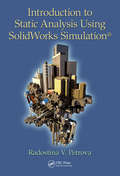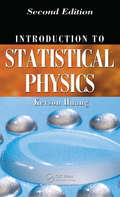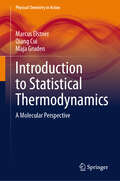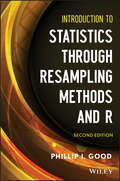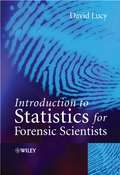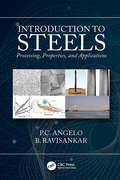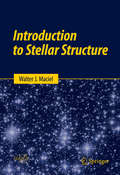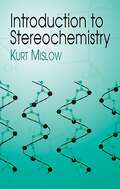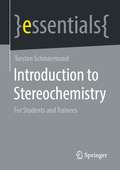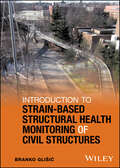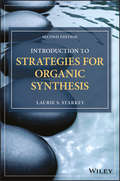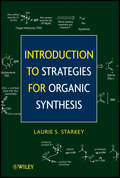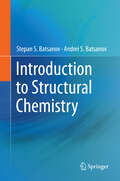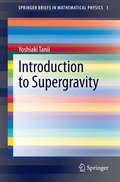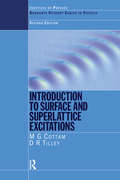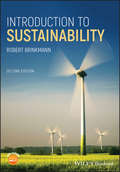- Table View
- List View
Introduction to Static Analysis Using SolidWorks Simulation
by Radostina V. PetrovaUses Finite Element Analysis (FEA) as Implemented in SolidWorks SimulationOutlining a path that readers can follow to ensure a static analysis that is both accurate and sound, Introduction to Static Analysis using SolidWorks Simulation effectively applies one of the most widely used software packages for engineering design to the concepts of static
Introduction to Statistical Methods for Biosurveillance
by Ronald D. FrickereBioterrorism is not a new threat, but in an increasingly interconnected world, the potential for catastrophic outcomes is greater today than ever. The medical and public health communities are establishing biosurveillance systems designed to proactively monitor populations for possible disease outbreaks as a first line of defense. The ideal biosurveillance system should identify trends not visible to individual physicians and clinicians in near-real time. Many of these systems use statistical algorithms to look for anomalies and to trigger epidemiologic investigation, quantification, localization, and outbreak management. This book discusses the design and evaluation of statistical methods for effective biosurveillance for readers with minimal statistical training. Weaving public health and statistics together, it presents basic and more advanced methods, with a focus on empirically demonstrating added value. Although the emphasis is on epidemiologic and syndromic surveillance, the statistical methods can be applied to a broad class of public health surveillance problems.
Introduction to Statistical Physics
by Kerson HuangWritten by a world-renowned theoretical physicist, Introduction to Statistical Physics, Second Edition clarifies the properties of matter collectively in terms of the physical laws governing atomic motion. This second edition expands upon the original to include many additional exercises and more pedagogically oriented discussions that fully explai
Introduction to Statistical Physics and to Computer Simulations
by João Paulo Casquilho Paulo Ivo Cortez TeixeiraRigorous and comprehensive, this textbook introduces undergraduate students to simulation methods in statistical physics. The book covers a number of topics, including the thermodynamics of magnetic and electric systems; the quantum-mechanical basis of magnetism; ferrimagnetism, antiferromagnetism, spin waves and magnons; liquid crystals as a non-ideal system of technological relevance; and diffusion in an external potential. It also covers hot topics such as cosmic microwave background, magnetic cooling and Bose–Einstein condensation. The book provides an elementary introduction to simulation methods through algorithms in pseudocode for random walks, the 2D Ising model, and a model liquid crystal. Any formalism is kept simple and derivations are worked out in detail to ensure the material is accessible to students from subjects other than physics.
Introduction to Statistical Thermodynamics: A Molecular Perspective (Physical Chemistry in Action)
by Qiang Cui Marcus Elstner Maja GrudenThis textbook presents the fundamentals of statistical thermodynamics and electronic structure theory and focuses on introducing the central concepts of thermodynamics and their relation to microscopic theories in a conceptually clear and simple way. The emphasis is on the description of what is going on at the microscopic level, which allows readers to understand the various facets of entropy as the fundamental driving force of all material behaviors. An atomistic perspective is introduced from the beginning, highlighting the importance of molecular structure and microscopic degrees of freedom for understanding the thermodynamic properties of materials, such as heat capacity and magnetization. Because of their importance in various research fields, classical and quantum aspects are treated equally, allowing modern research topics to be addressed with molecular simulation and electronic structure theory. It is a valuable resource for undergraduate and graduate students in chemistry,physics, and materials science, and its modular structure makes it suitable for any reader.
Introduction to Statistics Through Resampling Methods and R
by Phillip I. GoodA highly accessible alternative approach to basic statistics Praise for the First Edition: "Certainly one of the most impressive little paperback 200-page introductory statistics books that I will ever see . . . it would make a good nightstand book for every statistician."--Technometrics Written in a highly accessible style, Introduction to Statistics through Resampling Methods and R, Second Edition guides students in the understanding of descriptive statistics, estimation, hypothesis testing, and model building. The book emphasizes the discovery method, enabling readers to ascertain solutions on their own rather than simply copy answers or apply a formula by rote. The Second Edition utilizes the R programming language to simplify tedious computations, illustrate new concepts, and assist readers in completing exercises. The text facilitates quick learning through the use of: More than 250 exercises--with selected "hints"--scattered throughout to stimulate readers' thinking and to actively engage them in applying their newfound skills An increased focus on why a method is introduced Multiple explanations of basic concepts Real-life applications in a variety of disciplines Dozens of thought-provoking, problem-solving questions in the final chapter to assist readers in applying statistics to real-life applications Introduction to Statistics through Resampling Methods and R, Second Edition is an excellent resource for students and practitioners in the fields of agriculture, astrophysics, bacteriology, biology, botany, business, climatology, clinical trials, economics, education, epidemiology, genetics, geology, growth processes, hospital administration, law, manufacturing, marketing, medicine, mycology, physics, political science, psychology, social welfare, sports, and toxicology who want to master and learn to apply statistical methods.
Introduction to Statistics for Forensic Scientists
by David LucyIntroduction to Statistics for Forensic Scientists is an essential introduction to the subject, gently guiding the reader through the key statistical techniques used to evaluate various types of forensic evidence. Assuming only a modest mathematical background, the book uses real-life examples from the forensic science literature and forensic case-work to illustrate relevant statistical concepts and methods.Opening with a brief overview of the history and use of statistics within forensic science, the text then goes on to introduce statistical techniques commonly used to examine data obtained during laboratory experiments. There is a strong emphasis on the evaluation of scientific observation as evidence and modern Bayesian approaches to interpreting forensic data for the courts. The analysis of key forms of evidence are discussed throughout with a particular focus on DNA, fibres and glass.An invaluable introduction to the statistical interpretation of forensic evidence; this book will be invaluable for all undergraduates taking courses in forensic science.Introduction to the key statistical techniques used in the evaluation of forensic evidenceIncludes end of chapter exercises to enhance student understandingNumerous examples taken from forensic science to put the subject into context
Introduction to Steels: Processing, Properties, and Applications
by P.C. Angelo B. RavisankarThe book briefly describes the structure, properties and applications of various grades of steel, primarily aimed at non-metallurgical students from other engineering streams. The book consists of nine chapters covering most of the important types of steels and their physical metallurgy, microstructure and engineering applications including iron-carbon diagram, heat treatment, surface hardening methods, effect of alloying, specific applications, selection of materials, case studies and so forth. The book also contains subjective and objective questions aimed at exam preparation. Key Features Exclusive title aimed at introduction to steels for non-metallurgy audience Includes microstructure, composition, and properties of all the most commonly used steels Describes the heat treatments and the required alloying additions to process steel for the intended applications Discusses effects of alloying elements on steel Explores development of steels for specialized areas such as the automobile, aerospace, and nuclear industries
Introduction to Stellar Dynamics
by Luca CiottiThe study of stellar dynamics is experiencing an exciting new wave of interest thanks to observational campaigns and the ready availability of powerful computers. Whilst its relevance includes many areas of astrophysics, from the structure of the Milky Way to dark matter halos, few texts are suited to advanced students. This volume provides a broad overview of the key concepts beyond the elementary level, bridging the gap between the standard texts and specialist literature. The author reviews Newtonian gravity in depth before examining the dynamical properties of collisional and collisionless stellar-dynamical systems that result from gravitational interactions. Guided examples and exercises ensure a thorough grounding in the mathematics, while discussions of important practical applications give a complete picture of the subject. Readers are given a sound working knowledge of the fundamental ideas and techniques employed in the field and the conceptual background needed to progress to more advanced graduate-level treatises.
Introduction to Stellar Structure
by Walter J. MacielIn the first part of this book, the author presents the basic properties of the stellar interior and describes them thoroughly, along with deriving the main stellar structure equations of temperature, density, pressure and luminosity, among others. The process and application of solving these equations is explained, as well as linking these results with actual observations. The second part of the text describes what happens to a star over time and how to determine this by solving the same equations at different points during a star's lifetime. The fate of various stars is quite different depending on their masses and this is described in the final parts of the book. This text can be used for an upper level undergraduate course or an introductory graduate course on stellar physics.
Introduction to Stellar Structure (Springer Praxis Books)
by Walter J. MacielThis book provides a comprehensive overview of stellar structure, evolution and basic stellar properties. It includes integrated problems within the chapters, with worked solutions. In the first part of this book, the author presents the basic properties of the stellar interior and describes them thoroughly, along with deriving the main stellar structure equations of temperature, density, pressure and luminosity, among others. The process and application of solving these equations is explained, as well as linking these results with actual observations. The second part of the text describes what happens to a star over time and how to determine this by solving the same equations at different points during a star’s lifetime. The fate of various stars is quite different depending on their masses and this is described in the final parts of the book. This text can be used for an upper level undergraduate course or an introductory graduate course on stellar physics.
Introduction to Stereochemistry (Dover Books on Chemistry)
by Kurt MislowMolecular shape, form, and symmetry play a central role in organic chemistry, and this text presents a brief introduction to the conceptual basis of stereochemistry. Its focus lies in the fundamentals of structural stereochemistry, rather than the dynamic aspects that are more relevant to reaction mechanisms. The three-part treatment deals with structure and symmetry, stereoisomerism, and the separation and configuration of stereoisomers.The first section reviews molecular architecture, relating empirical bonding geometries to the hybridization of the central carbon atom. Students receive a nonrigorous treatment of symmetry elements and point groups, with particular focus on the presence or absence of reflection symmetry. The second section classifies stereoisomers according to symmetry properties and to the nature of their barriers; it also discusses the dependence of optical activity on structure and concludes with an examination of topological isomerism. The third and final section explores the conceptual basis of asymmetric syntheses and kinetic resolutions. Each of the major sections features a series of exercises that reinforce and extend the preceding material, and answers are provided. Preface to the Dover edition. Answers to Exercises. Bibliography. Index.
Introduction to Stereochemistry: For Students and Trainees (essentials)
by Torsten SchmiermundConformal, diastereomers, rotamers, tautomers, anomers: The multitude of terms used in stereochemistry quickly makes this subfield of chemistry confusing. In addition, there are different nomenclatures and different forms of representation (Fischer projection, Haworth ring formula, Newman projection). This essential deals with basic static stereochemistry and gives an overview of the different isomeric forms and nomenclatures. It is thus both a help and a reference book. This Springer essential is a translation of the original German 1st edition essentials, Einführung in die Stereochemie by Torsten Schmiermund, published by Springer Fachmedien Wiesbaden GmbH, part of Springer Nature in 2019. The translation was done with the help of artificial intelligence (machine translation by the service DeepL.com). A subsequent human revision was done primarily in terms of content, so that the book will read stylistically differently from a conventional translation. Springer Nature works continuously to further the development of tools for the production of books and on the related technologies to support the authors.
Introduction to Strain-Based Structural Health Monitoring of Civil Structures
by Branko GlisicA comprehensive introduction to strain-based structural health monitoring of civil structures, with focus on measurement and data analysis Introduction to Strain-Based Structural Health Monitoring of Civil Structures focuses on the SHM of civil structures and infrastructure, and develops the relevant topics of measurement and data analysis from a fundamental to advanced level. The book contains an overview of the available and emerging strain monitoring technologies like traditional strain-gauges and vibrating wire sensors, discrete and distributed fiber optic sensors, and large area electronics. The fundamentals of error analysis, as well as typical sources of errors in measurements, are discussed. Sources of strain in typical construction materials such concrete, steel, timber, and composite materials are also discussed, while both basic and advanced data interpretation and analysis for monitoring of concrete and steel structures are presented in detail. Methods applicable to a large spectrum of beam-like structural elements and civil structures, such as bridges, buildings, and pipelines, are summarized. These methods are developed at three scales: local scale (material or structural), global (structural) scale, and integrity scale, and are illustrated with practical examples. Key features: Defines and describes SHM and identifies its main components and stakeholders. Explores the potential and benefits as well as the limitations of SHM. Introduces strain-based structural health monitoring of civil structures, with focus on measurement and data analysis. Covers the physical principles, advantages, and limitations of various types of sensors. Covers fundamental error analysis and presents typical sources of errors. Covers the sources of short- and long-term strain, and how to interpret the strain measurement. Includes basic and advanced model-based methods for data analysis. Contains the basic strain-based SHM methods for monitoring various types of structures at local, global, and integrity scale. Suitable as a guide for practicing engineers, a reference for infrastructure owners, and a textbook for researchers and SHM university courses. A valuable companion to Glisic & Inaudi’s Fibre Optic Methods for Structural Health Monitoring. Introduction to Strain-Based Structural Health Monitoring of Civil Structures is essential, state-of-the-art reading for civil and structural engineers and professionals in SHM, as well as teachers, researchers, and students in civil engineering.
Introduction to Strategies for Organic Synthesis
by Laurie S. StarkeyBridging the Gap Between Organic Chemistry Fundamentals and Advanced Synthesis Problems Introduction to Strategies of Organic Synthesis bridges the knowledge gap between sophomore-level organic chemistry and senior-level or graduate-level synthesis to help students more easily adjust to a synthetic chemistry mindset. Beginning with a thorough review of reagents, functional groups, and their reactions, this book prepares students to progress into advanced synthetic strategies. Major reactions are presented from a mechanistic perspective and then again from a synthetic chemist’s point of view to help students shift their thought patterns and teach them how to imagine the series of reactions needed to reach a desired target molecule. Success in organic synthesis requires not only familiarity with common reagents and functional group interconversions, but also a deep understanding of functional group behavior and reactivity. This book provides clear explanations of such reactivities and explicitly teaches students how to make logical disconnections of a target molecule. This new Second Edition of Introduction to Strategies for Organic Synthesis: Reviews fundamental organic chemistry concepts including functional group transformations, reagents, stereochemistry, and mechanisms Explores advanced topics including protective groups, synthetic equivalents, and transition-metal mediated coupling reactions Helps students envision forward reactions and backwards disconnections as a matter of routine Gives students confidence in performing retrosynthetic analyses of target molecules Includes fully-worked examples, literature-based problems, and over 450 chapter problems with detailed solutions Provides clear explanations in easy-to-follow, student-friendly language Focuses on the strategies of organic synthesis rather than a catalogue of reactions and modern reagents The prospect of organic synthesis can be daunting at the outset, but this book serves as a useful stepping stone to refresh existing knowledge of organic chemistry while introducing the general strategies of synthesis. Useful as both a textbook and a bench reference, this text provides value to graduate and advanced undergraduate students alike.
Introduction to Strategies for Organic Synthesis
by Laurie StarkeyThe stepping-stone text for students with a preliminary knowledge of organic chemistry looking to move into organic synthesis research and graduate-level coursework Organic synthesis is an advanced but important field of organic chemistry, however resources for advanced undergraduates and graduate students moving from introductory organic chemistry courses to organic synthesis research are scarce. Introduction to Strategies for Organic Synthesis is designed to fill this void, teaching practical skills for making logical retrosynthetic disconnections, while reviewing basic organic transformations, reactions, and reactivities. Divided into seven parts that include sections on Retrosynthesis and Protective Groups; Overview of Organic Transformations; Synthesis of Monofunctional Target Molecules; Synthesis of Target Molecules with Two Functional Groups; Synthesis of Aromatic Target Molecules; Synthesis of Compounds Containing Rings; and Predicting and Controlling Stereochemistry, the book covers everything students need to successfully perform retrosynthetic analyses of target molecule synthesis. Starting with a review of functional group transformations, reagents, and reaction mechanisms, the book demonstrates how to plan a synthesis, explaining functional group analysis and strategic disconnections. Incorporating a review of the organic reactions covered, it also demonstrates each reaction from a synthetic chemist's point of view, to provide students with a clearer understanding of how retrosynthetic disconnections are made. Including detailed solutions to over 300 problems, worked-through examples and end-of-chapter comprehension problems, Introduction to Strategies for Organic Synthesis serves as a stepping stone for students with an introductory knowledge of organic chemistry looking to progress to more advanced synthetic concepts and methodologies.
Introduction to String Theory (Theoretical and Mathematical Physics)
by Sergio CecottiGraduate students typically enter into courses on string theory having little to no familiarity with the mathematical background so crucial to the discipline. As such, this book, based on lecture notes, edited and expanded, from the graduate course taught by the author at SISSA and BIMSA, places particular emphasis on said mathematical background. The target audience for the book includes students of both theoretical physics and mathematics. This explains the book’s "strange" style: on the one hand, it is highly didactic and explicit, with a host of examples for the physicists, but, in addition, there are also almost 100 separate technical boxes, appendices, and starred sections, in which matters discussed in the main text are put into a broader mathematical perspective, while deeper and more rigorous points of view (particularly those from the modern era) are presented. The boxes also serve to further shore up the reader’s understanding of the underlying math. In writing this book, the author’s goal was not to achieve any sort of definitive conciseness, opting instead for clarity and "completeness". To this end, several arguments are presented more than once from different viewpoints and in varying contexts.
Introduction to Strings and Branes
by Peter WestSupersymmetry, strings and branes are believed to be the essential ingredients in a single unified consistent theory of physics. This book gives a detailed, step-by-step introduction to the theoretical foundations required for research in strings and branes. After a study of the different formulations of the bosonic and supersymmetric point particles, the classical and quantum bosonic and supersymmetric string theories are presented. This book includes accounts of brane dynamics and D-branes and the T, S and U duality symmetries of string theory. The historical derivation of string theory is given as well as the sum over the world-sheet approach to the interacting string. More advanced topics include string field theory and Kac–Moody symmetries. The book contains pedagogical accounts of conformal quantum field theory, supergravity theories, Clifford algebras and spinors, and Lie algebras. It is essential reading for graduate students and researchers wanting to learn strings and branes.
Introduction to Strong Interactions: Theory and Applications
by Andrey GrabovskyThis is a problem-oriented introduction to the main ideas, methods, and problems needed to form a basic understanding of the theory of strong interactions. Each section contains solid but concise technical foundations to key concepts of the theory, and the level of rigor is appropriate for readers with a background in physics (rather than mathematics). It begins with a foundational introduction to topics including SU(N) group, hadrons and effective SU(3) symmetric flavor lagrangians, constituent quarks in hadrons, quarks and gluons as fundamental fields. It then discusses Quantum chromodynamics as a gauge field theory, functional integration, and Wilson lines and loops, before moving on to discuss gauge–fixing and Faddeev – Popov ghosts, Becchi-Rouet-Stora-Tyutin symmetry, and lattice methods. It concludes with a discussion on the anomalies and the strong CP problem, effective action, chiral perturbation theory, deep inelastic scattering, and derivation and solution of the Dokshitzer - Gribov - Lipatov - Altarelli - Parisi equations. Constructed as a one-term course on strong interactions for advanced students, it will be a useful self-study guide for graduate and PhD students of high energy physics, Quantum Chromodynamics, and the Standard Model.
Introduction to Structural Chemistry
by Stepan S. Batsanov Andrei S. BatsanovA concise description of models and quantitative parameters in structural chemistry and their interrelations, with 280 tables and >3000 references giving the most up-to-date experimental data on energy characteristics of atoms, molecules and crystals (ionisation potentials, electron affinities, bond energies, heats of phase transitions, band and lattice energies), optical properties (refractive index, polarisability), spectroscopic characteristics and geometrical parameters (bond distances and angles, coordination numbers) of substances in gaseous, liquid and solid states, in glasses and melts, for various thermodynamic conditions. Systems of metallic, covalent, ionic and van der Waals radii, effective atomic charges and other empirical and semi-empirical models are critically revised. Special attention is given to new and growing areas: structural studies of solids under high pressures and van der Waals molecules in gases. The book is addressed to researchers, academics, postgraduates and advanced-course students in crystallography, materials science, physical chemistry of solids.
Introduction to Structural Dynamics and Aeroelasticity
by Dewey H. Hodges G. Alvin PierceThis text provides an introduction to structural dynamics and aeroelasticity, with an emphasis on conventional aircraft. The primary areas considered are structural dynamics, static aeroelasticity, and dynamic aeroelasticity. The structural dynamics material emphasizes vibration, the modal representation, and dynamic response. Aeroelastic phenomena discussed include divergence, aileron reversal, airload redistribution, unsteady aerodynamics, flutter, and elastic tailoring. More than one hundred illustrations and tables help clarify the text, and more than fifty problems enhance student learning. This text meets the need for an up-to-date treatment of structural dynamics and aeroelasticity for advanced undergraduate or beginning graduate aerospace engineering students. Praise from the First Edition "Wonderfully written and full of vital information by two unequalled experts on the subject, this text meets the need for an up-to-date treatment of structural dynamics and aeroelasticity for advanced undergraduate or beginning graduate aerospace engineering students. " - Current Engineering Practice "Hodges and Pierce have written this significant publication to fill an important gap in aeronautical engineering education. Highly recommended. " - Choice ". . . a welcome addition to the textbooks available to those with interest in aeroelasticity. . . . As a textbook, it serves as an excellent resource for advanced undergraduate and entry-level graduate courses in aeroelasticity. . . . Furthermore, practicing engineers interested in a background in aeroelasticity will find the text to be a friendly primer. " - AIAA Bulletin
Introduction to Superfluidity
by Andreas SchmittSuperfluidity - and closely related to it, superconductivity - are very general phenomena that can occur on vastly different energy scales. Their underlying theoretical mechanism of spontaneous symmetry breaking is even more general and applies to a multitude of physical systems. In these lecture notes, a pedagogical introduction to the field-theory approach to superfluidity is presented. The connection to more traditional approaches, often formulated in a different language, is carefully explained in order to provide a consistent picture that is useful for students and researchers in all fields of physics. After introducing the basic concepts, such as the two-fluid model and the Goldstone mode, selected topics of current research are addressed, such as the BCS-BEC crossover and Cooper pairing with mismatched Fermi momenta.
Introduction to Supergravity
by Yoshiaki TaniiThis book is a pedagogical introduction to supergravity, a gravitational field theory that includes supersymmetry (symmetry between bosons and fermions) and is a generalization of Einstein's general relativity. Supergravity provides a low-energy effective theory of superstring theory, which has attracted much attention as a candidate for the unified theory of fundamental particles, and it is a useful tool for studying non-perturbative properties of superstring theory such as D-branes and string duality. This work considers classical supergravities in four and higher spacetime dimensions with their applications to superstring theory in mind. More concretely, it discusses classical Lagrangians (or field equations) and symmetry properties of supergravities. Besides local symmetries, supergravities often have global non-compact symmetries, which play a crucial role in their applications to superstring theory. One of the main features of this book is its detailed discussion of these non-compact symmetries. The aim of the book is twofold. One is to explain the basic ideas of supergravity to those who are not familiar with it. Toward that end, the discussions are made both pedagogical and concrete by stating equations explicitly. The other is to collect relevant formulae in one place so as to be useful for applications to string theory. The subjects discussed in this book include the vielbein formulation of gravity, supergravities in four dimensions, possible types of spinors in various dimensions, superalgebras and supermultiplets, non-linear sigma models for non-compact Lie groups, electric-magnetic duality symmetries, supergravities in higher dimensions, dimensional reductions, and gauged and massive supergravities.
Introduction to Surface and Superlattice Excitations (Graduate Student Series In Physics Ser.)
by Michael G. Cottam D.R. TilleyCottam and Tilley provide an introduction to the properties of wave-like excitations associated with surfaces and interfaces. The emphasis is on acoustic, optic and magnetic excitations, and apart from one section on liquid surfaces, the text concentrates on solids. The important topic of superlattices is also discussed, in which the different kinds of excitation are considered from a unified point of view. Throughout the book, the authors are careful to relate theory and experiment and all of the most important experimental techniques are described. The theoretical treatment assumes only a knowledge of undergraduate physics, except for Green function methods that are used in a few sections; these methods are developed in an appendix. The book also contains extensive references, enabling the reader to consult the research and review literature. Each of the main chapters contains problems to allow the reader to develop topics presented in the text.
Introduction to Sustainability
by Robert BrinkmannIntroduction to Sustainability, Second Edition, reviews all the major themes in the cutting-edge field of sustainability. The book is suitable for introductory interdisciplinary courses on sustainability, as well as those in the fields of geography, geology, sociology, planning, political science, and anthropology. Allowing students to see the world in new ways while also encouraging them to become part of the change needed to ensure the long-term sustainability of the planet, this book is an invaluable introduction to this multifaceted and ever-changing subject. Now fully revised and updated, this second edition includes new material on the most recent developments in the field of sustainability; environmental sustainability issues like water, food, and energy; social sustainability themes like environmental justice and transportation; and economic sustainability topics like green businesses and economic development. The book concludes with a chapter on sustainability issues in college and universities. Brinkmann intersperses many fascinating case studies and text boxes that encourage students to deeply explore the material. This is a book that not only organizes the complex field of sustainability, but also encourages students to take action to make the world a better place.
